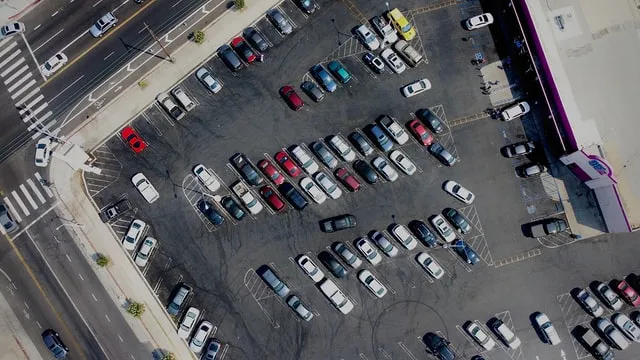Smart parking will make parking efficient as it solves the number one problem everyone has with it – finding free spots.
If you ever drove through a city and spent 10 or 15 minutes finding a good spot near your destination or if you were at a shopping mall and spent more time searching for a free parking spot than actually buying things, then this technology will be a lifesaver for you.
Find out what smart parking is, how it works, and what its advantages, as well as disadvantages are.
What is Smart Parking?
Smart parking is an IoT (Internet of Things) solution that uses sensors and/or cameras in combination with a software to inform users of vacant parking spaces in a certain area. Most of the time, people can also directly reserve the spot and pay for it with an app.
How Does Smart Parking Work?
It should not be confused with mobile parking. This is only a way to pay with your phone or smartphone, to extend the parking time and find your car. Here you still need to find free spots by yourself.
The way smart parking works is, that a sensor detects if, or if not, a car is standing on a parking spot. This can either be a proximity sensor or often also a camera. The advantage of using a camera is that it can view a wider space. On the other hand, if the environment is not ideal for one of these, for example if trees or objects are in the way, then they can become quite expensive in comparison to sensors.
After the sensor detected a change (parking space free or not) on the parking spot, it sends a message to the cloud of the provider. Afterwards, the user receives a notification that there is a free parking space and gets the direction towards it.
When the user leaves the spot, the procedure gets repeated and other people get notified.
Advantages of Smart Parking
Smart parking systems can be a great opportunity to improve current traffic processes in cities. There are numerous advantages to these technologies, such as the following.
- Reduces Traffic
By always directly showing a user where there is a free spot, smart parking can reduce the time searching for it. Cars wouldn’t drive around blocks and slow down if there might be a spot. - Reduces Emissions
In addition to the point mentioned previously, by reducing traffic, it also reduces the emissions of cars. - Security
In addition to the improved efficiency, smart parking systems also provide security for the designated area. The software can understand which user tries to reserve a parking spot and can allow or deny access. Especially for offices or restricted areas, this can be a good solution to control who can enter the area. - Real Time Traffic Data
With the data collected of the parking spots, cities can better analyse their traffic and thus improve its efficiency and detect errors. - Manage Retail or Office Parking
Not only cities will see benefits in using smart parking technology, also large office or retail parking lots can. For companies with a high number of employees that come by car, the technology can reduce time, emissions and costs of running the car. - Help Cities to Become Smart
Smart parking is a step into the direction of smart cities. By connecting buildings, cars, transportation and other public services, our future cities can become more efficient and sustainable.

Disadvantages of Smart Parking
On one hand, these systems have a lot of potential use cases for cities and private owners. On the other hand, they are not getting implemented on a large scale yet. This might be due to some of the following disadvantages.
- High Installation Costs
The initial costs of installing a smart parking system can be quite substantial. There are a lot of factors that influence the price and it might even be difficult to estimate the exact number, especially in very complex areas.
One issue within cities are objects that are placed on or beside the street, which makes it harder for sensors to identify the parking spots. As a result, more cameras or sensors need to be installed which will increase the installation cost. - Getting a Permission
Another downside can be the difficulty in getting a permit from local authorities. If a private company wants to implement a smart parking system within a city, they need to get approval from the local government. Sometimes this might not be possible or in other cases might take a long time until a decision has been made. - Maintenance
Maintenance and repairs are important for smart parking systems, as they might not function properly due to a number of problems. Sensors can be damaged, leaves or dirt might block a camera, or there are software issues. All of that needs regular maintenance which can become costly. Overall, these costs are still likely cheaper than traditional parking spot systems. - User Operation
One last disadvantage can be the operation of the app to reserve a parking spot. For some users, it might be difficult to book a spot using the platform as it is different from the usual process. Therefore, a user-friendly design is an important aspect of a smart parking solution.
Successful Examples of Smart Parking
Smart parking has not been adopted to a large extent throughout many countries. Some cities though have taken the initiative and shown successful use of the technology.
San Francisco
San Francisco has introduced “SFPark”, which is the first smart parking system in the city. $20 million have been invested in sensors that are installed in parking spots and the pavement. In combination with a smartphone app, citizens are able to find and book parking spaces throughout San Francisco.
Singapore
Another city that is testing smart parking, is Singapore. Their application is called parking.sg and allows citizens to enter parking spaces by only scanning their licence plate. When a car enters the assigned space, lights and sensors show them the way to the next free spot.
Costs of Smart Parking
The pricing for smart parking systems depends on various factors such as: the size of the parking lot, the shape of it, if objects are in its way (trees, lamps, …) and the features of the user-software.
There is not a direct estimate of how much the smart parking system will cost you, but we would recommend you to take a look at an example of the United States Department of Transportation.
The system for two roadsides (50 parking spots) with sensors and a reservation app was estimated at around $200,000. The initial installation costs consist mostly of sensors and the application. By using cameras instead of sensors and a less custom software, these costs can be reduced. The more smart parking systems will be installed, the lower the unit cost will be in the end.
Conclusion
Smart parking is a good investment for cities that have lots of traffic problems and want to increase their efficiency. Also, for commercial real estate, this can be quite interesting. Especially for large parking lots in front of shopping malls, offices and industrial buildings, the technology can help to reduce emissions, time spent on searching for parking spots and costs.
If you want to learn more about the future of commercial real estate, including topics such as sustainability & ESG, PropTech, architecture, development and investment, feel free to take a look at our other articles on Smart CRE. Here you will also find insights into the job market and how to start a career in real estate.
To stay up-to-date, we would be very happy if you subscribe to our monthly newsletter. Just enter your e-mail address below. Thank you!

